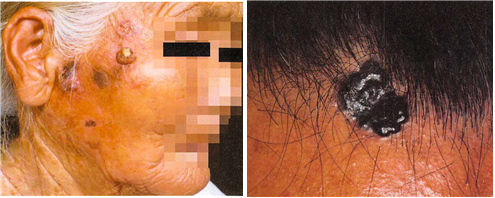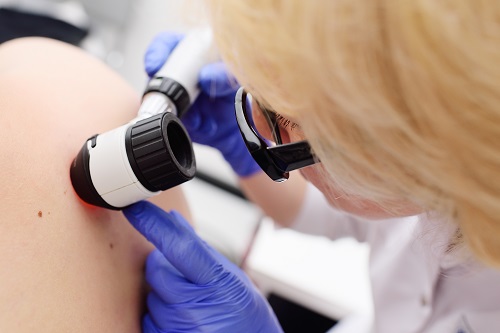Be suspicious when the mole grows, accompanied by a sudden color change, bleeding, or ulceration.
The most reliable treatment is 'surgery'…Early diagnosis and treatment are essential.

It was commonly believed that 'Skin cancer' was most likely to occur in Westerners. In the case of Asians, including in Korea, the incidence of skin cancer was relatively low in the past, but it is showing a continuous increase in recent years. In the season when ultraviolet rays, the most significant cause of skin cancer, become more robust, it is necessary to look at skin cancer prevention methods and self-diagnosis methods that can be checked by oneself and carefully prepare for skin cancer.
In particular, early diagnosis is critical because the possibility of metastasis to other organs is high if you confuse malignant melanoma, one of the skin cancers, with a simple mole. Accordingly, through a discussion with Huh Chang-Hoon, a dermatologist at Seoul National University Bundang Hospital, and Kim Hyeon-Jo, a dermatologist (Director of CNP Cha & Park Dermatology Cheonan Buldang Branch), we looked at skin cancer symptoms in detail and treatment.

Reporter Han Jeong-Sun: What are the types of skin cancer?
Professor Heo Chang-Hoon: Skin cancer is primarily divided into three categories, in the order in which it occurs the most, basal cell cancer, squamous cell cancer, and melanoma. Basal cell carcinoma has a high prevalence, accounting for 80-90% of all skin cancers.
Reporter Han Jeong-Sun: What are the causes of skin cancer?
Professor Huh Chang-Hoon: When damaged tissue is regenerated, tissue growth continues in a state of mutation. The more the damage is repeated, the more mutations are bound to occur. Ultraviolet rays are the most common cause of repeated damage and the cause of skin cancer.

Reporter Han Jeong-Sun: How is skin cancer different from mole and pigment disease?
Specialist Kim Hyun-Jo: Early skin cancer is difficult to discern from moles because there are no subjective symptoms. However, skin cancer may be suspected if the number and size of dots increases in a short period, accompanied by symptoms such as color change, bleeding, and ulcers. In particular, malignant melanoma is about 4% of all skin cancers in the United States. Still, it is fatal enough to account for about 75% of skin cancer-related deaths, so early diagnosis and treatment are essential. We introduce the ABCDE TIPs, a method for distinguishing moles from malignant melanoma.
① Asymmetry
② Border irregularity
③ Color variegation
④ Diameter
⑤ Evolution

Reporter Han Jeong-Sun: What risks if skin cancer is left unattended?
Professor Heo Chang-Hoon: Among skin cancers, melanoma is a severe disease, but the progress of more than 95% of skin cancers is not very serious. Most of them have little metastasis and do not need chemotherapy. However, if not treated, it may cause functional problems by destroying surrounding tissues, and the scar may become even more prominent. Hence, it is more reasonable to treat it as soon as possible.

Reporter Han Jeong-Sun: What are the adequate treatments for skin cancer.
Professor Huh Chang-Hoon: The most favorable treatment for skin cancer is surgery. The most significant concern in skin cancer surgery is the judgment of how many safety areas, including normal cells, will be placed. The wider the safety area, the more likely it is to remove cancer cells altogether, but it can leave a lot of scars. So efforts are made to minimize the safety area. One of the effective methods, "mose micrographic surgery," allows minimal resection by histologically checking the boundary of skin cancer. Still, also it has a disadvantage in that the surgery time is much longer. In addition, electrospun surgery, refrigeration surgery, wide-area motion therapy, radiation therapy, topical application therapy, and chemotherapy can be considered if surgery looks too problematic.
Reporter Han Jeong-Sun: If skin cancer is misdiagnosed with widespread skin disease and treated, what are the side effects?
Specialist Kim Hyun-Jo: In the case of basal cell cancer and squamous cell cancer, which are relatively less likely to metastasize, if treatment is delayed due to misdiagnosis, the size and depth will increase, and the normal skin should be removed more. In addition, early diagnosis is vital in the case of malignant melanoma because if the treatment period is missed and metastasized to a different organ from the local lymph node, the 5-year survival rate falls below 30%. There are cases of patient whose malignant melanoma was misdiagnosed as a simple mole at the clinic. The melanoma spread to various organs after laser removal, and he had to die.

Reporter Han Jeong-Sun: Can patients receive insurance benefits for skin cancer treatment?
Professor Heo Chang-Hoon: Since removing pigmentation diseases such as moles and age spots is a cosmetic procedure, health insurance is not applied. Some conditions should be subject to VAT. However, skin cancer is not only covered by health insurance but also registered as a severe patient so that medical expenses can be reduced for five years and benefits from the year-end settlement. Therefore, if skin cancer is suspected, it is best to seek a diagnosis from a specialist as soon as possible.
Reporter Han Jeong-Sun: What procedures should be followed for suspected skin cancer?
Specialist Kim Hyun-Jo: It is a principle that applies to all diseases, but early diagnosis and treatment of skin cancer are also the most essential. Even with no specific symptoms, you should see a doctor immediately. Otherwise, the lesion will grow and aggravate, which may cause various side effects. If you are diagnosed with skin cancer in a biopsy, it is crucial to initiate appropriate treatment fast, considering skin cancer type, depth, and size.


